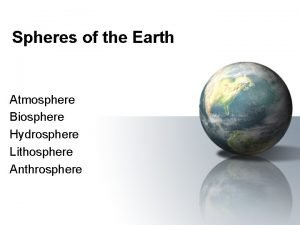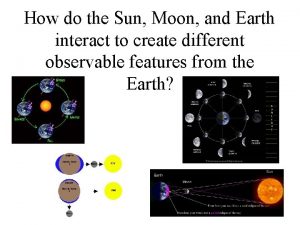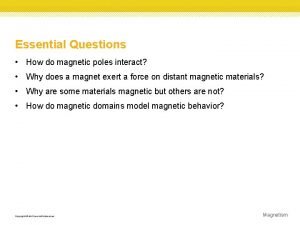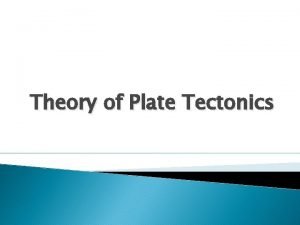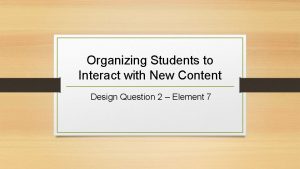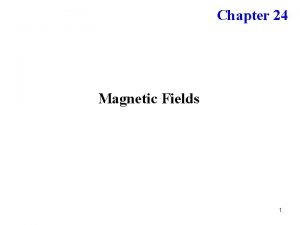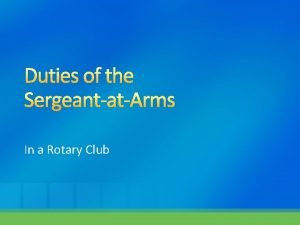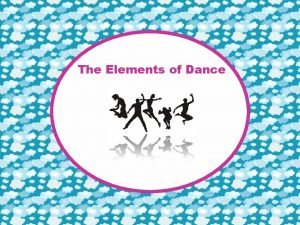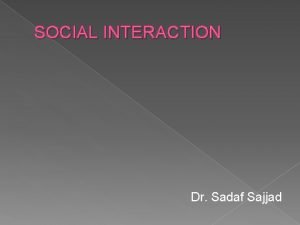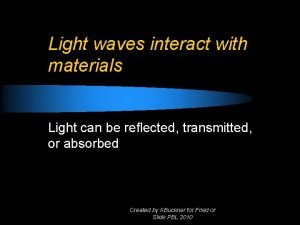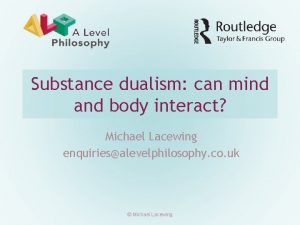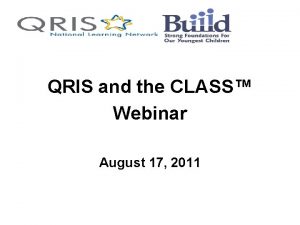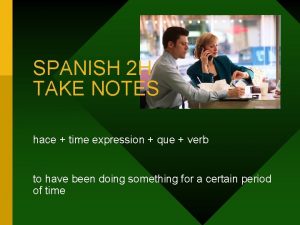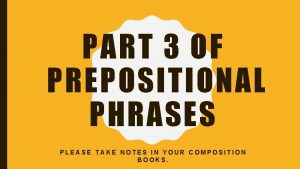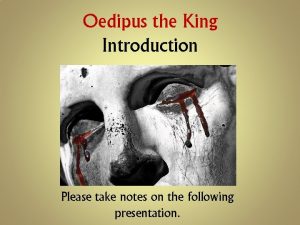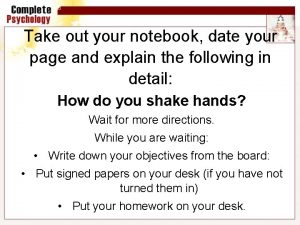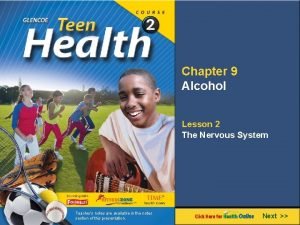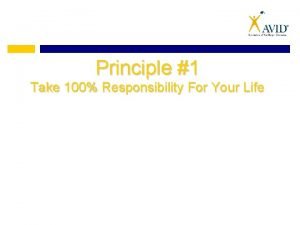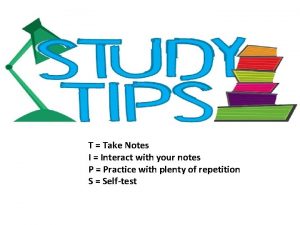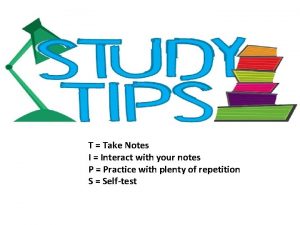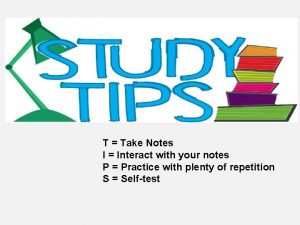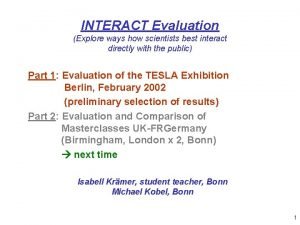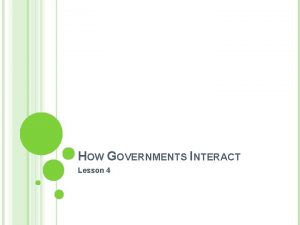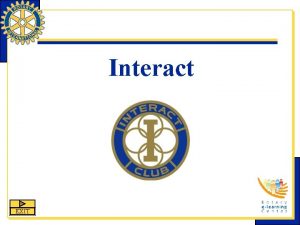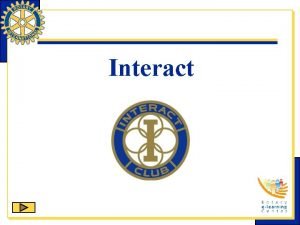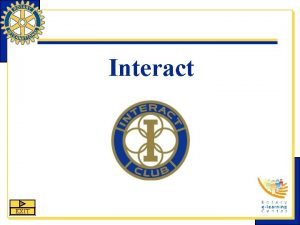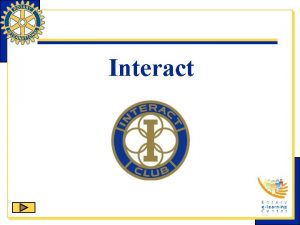T Take Notes I Interact with your notes







































- Slides: 39

T = Take Notes I = Interact with your notes P = Practice with plenty of repetition S = Self=test

CHAPTER 4 SECTION 2: THE QUANTUM MODEL OF THE ATOM

ESSENTIAL QUESTIONS • What is a “quantum” of energy? • What is a photon? • How is an electron related to a photon? • What are some examples of energy rules electrons within electron clouds obey? • What causes spectral lines? • Why are spectral lines considered evidence of energy levels within an atom’s electron cloud?

QUANTUM THEORY AND CHEMISTRY • Atoms interact with other atoms through electrons. Interactions such as forming chemical bonds occur through electrons. • When electrons are confined in an atom, their wave properties force them into specific patterns called quantum states that minimize the total energy of the atom.

THE EARLY EVIDENCE • In 1870, English scientist William Crookes created a sealed glass tube and pumped out virtually all of the air inside. • Englishman, J. J. Thomson, devised a series of experiments that showed cathode rays were deflected by magnets and were also deflected toward a positively charged plate, and away from a negative plate.

INTERACTIVE • Re-create Thomson's experiment in the interactive simulation titled Thomson's Discovery. Experiment with different atoms and plate charges.

RADIOACTIVITY • In 1898, French scientists Marie and Pierre Curie discovered that uranium spontaneously emitted some form of energy that they named radioactivity. • In 1899, Ernest Rutherford's team identified two forms of energy emitted by uranium, which he named alpha and beta.

THE GOLD FOIL EXPERIMENT • A stream of high speed alpha particles was shot at a thin gold foil. • Alpha particles were detected at different angles after passing through the foil. • Most of the alpha particles passed through completely unaffected, as if they had somehow completely missed every atom. • Very few alpha particles bounced off at large angles and about 1 in 20, 000 even bounced backward!

WHAT IS A WAVE • The highest point of a wave is called the crest and the lowest is called the trough. • The distance from one crest to another is called the wavelength. • The amplitude of a wave is measured as half the distance from the crest to the trough.

WAVE EQUATIONS • The relationship between wavelength and frequency is illustrated by the equation; c = λν • Wavelength is the Greek letter lambda, λ and frequency is the letter nu, ν. • The energy of a wave (E) is calculated by multiplying the frequency of the wave by a constant called Plank’s constant (h). E = hν

SOLVED PROBLEM What is the energy of an orange light that has a wavelength of 640. nm? Given λ = 640. nm or 6. 40 x 10 -7 m Relationship c = λν; E = hν ; c = 2. 998 x 108 m/s; h = 6. 626 x 10 s 34 J·s Solve First use the equation c = λν to find frequency 2. 998 x 108 m/s = 6. 40 x 10 -7 m × ν Then use the equation E = hν to find energy. Answer An orange light has 3. 10 x 10 -19 J of energy.

LIGHT AND ATOMS • Virtually all visible light comes from the oscillations of electrons in atoms.

THE PUZZLE OF SPECTRAL LINES • When electricity is passed through hydrogen gas, the gas glows and gives off very specific colors and nothing in between. • Johann Balmer discovered that the colors of light in the obeyed a precise mathematical relationship, named Balmer’s formula in his honor.

THE BOHR MODEL OF THE ATOM • Danish physicist Niels Bohr deduced a brilliant explanation for Balmer’s formula. • Bohr proposed that the electron makes circular orbits around the nucleus.

THE UNCERTAINTY PRINCIPLE • Heisenberg's uncertainty principle says that there is a limit to how accurately you can either know where an electron is, or its direction and velocity.

THE WAVE/PARTICLE MODEL • The word "quanta" means a discrete unit that cannot be subdivided. • The quantum theory of light states that light is a stream of tiny discrete energy bundles. • Each energy bundle is one photon. • The quantum theory of light is very different from the wave theory.

ELECTRON WAVES IN ATOMS • When Schrödinger's equation was applied to an electron bound to a proton, an amazing discovery was made. 1. The electron wave forms a sequence of three-dimensional "standing wave" patterns 2. Each pattern corresponded to a specific energy for an electron 3. The differences in energy between one pattern and another were exactly equal to the photon energies of the spectral lines in hydrogen

QUANTUM STATES • Each unique standing wave pattern is called a quantum state. • The probability of finding an electron in a quantum state is virtually 100%. • Electrons in atoms are either in a quantum state or moving from one state to another.

THE S, P, D, AND F ORBITALS • The wave patterns or orbitals are named s, p, d, and f. • The "s" orbital is spherically symmetric around the nucleus and can hold 2 electrons. • The "p" orbital has 3 sub-orbitals aligned with 3 coordinate axes. Each suborbital can hold 2 electrons for a total of 6. • The "d" orbital has a more complex shape and can hold a maximum of 10 electrons. The "f" orbitals can hold 14 electrons.

ENERGY LEVELS • An energy level is a group of orbitals that have similar energy. • The Aufbau principle states that electrons fill the lowest energy orbitals before higher energy orbitals.

RULES FOR WRITING ELECTRON CONFIGURATION • The ways in which electrons are arranged in various orbitals around the nuclei of atoms are called electron configurations. • Three rule: • The aufbau principle • The Pauli exclusion principle • The. Hund’s rule

AUFBAU PRINCIPLE • According to the aufbau principle, electrons occupy the orbitals of lowest energy first. In the aufbau diagram below, each box represents an atomic orbital.

PAULI EXCLUSION PRINCIPLE • The Pauli exclusion principle states that no two electrons in the same atom can be in the same quantum state at the same time. • Spin is a quantum property than can have only two values: +1/2 and -1/2. • Each orbital (or sub-orbital) can hold two electrons • They do not have the exact same quantum state: one electron is spin +1/2 and the other is spin -1/2.

HUND’S RULE • Hund's Rule states that electrons fill orbitals separately before doubling up.

GROUND AND EXCITED STATES • The ground state is the lowest energy configuration of an atoms. • An excited state occurs when one or more electrons occupies an orbital higher than the ground state.

EMISSION AND ABSORPTION OF LIGHT • Any atom may go from the ground state to an excited state by absorbing energy. • An atom may ONLY absorb a photon of light IF the photon matches the energy difference between two energy levels AND the higher energy level is unoccupied.

SPECTROSCOPY • A spectrum shows the individual colors that correspond to the energy transitions between energy levels. • Spectroscopy is the study of spectra for research and technology. • An instrument that disperses light into its constituent wavelengths is called a spectrometer.

POST-ASSESSMENT • What is a “quantum” of energy?

POST-ASSESSMENT • What is a “quantum” of energy? – A quantum is the smallest "bit" or amount of energy possible.

POST-ASSESSMENT • What is a photon?

POST-ASSESSMENT • What is a photon? – A photon is a quantum of light.

POST-ASSESSMENT • How is an electron related to a photon?

POST-ASSESSMENT • How is an electron related to a photon? – Both are particles, both act like waves. Electrons can emit photons when they return from excited state to ground state, but photons cannot emit electrons.

POST-ASSESSMENT • What are some examples of energy rules electrons within electron clouds obey?

POST-ASSESSMENT • What are some examples of energy rules electrons within electron clouds obey? – Electrons fill the lowest energy level first; no 2 electrons can be in the same place at the same time; orbitals can only hold 2 electrons but electrons fill orbitals singly before they pair up.

POST-ASSESSMENT • What causes spectral lines?

POST-ASSESSMENT • What causes spectral lines? – When an electron absorbs enough energy to go to an excited state, the electron releases a photon of light when it returns to ground state. Spectral lines are the visible energies of released photons.

POST-ASSESSMENT • Why are spectral lines considered evidence of energy levels within an atom’s electron cloud?

POST-ASSESSMENT • Why are spectral lines considered evidence of energy levels within an atom’s electron cloud? – Spectral lines only appear if the minimum energy is absorbed by electrons, and the released photons themselves have specific energy that relates to the quantum structure.
 Take a bus or take a train
Take a bus or take a train Interact with sunbird or moon
Interact with sunbird or moon How does biosphere interact with hydrosphere
How does biosphere interact with hydrosphere Why do organisms interact with other organisms
Why do organisms interact with other organisms How organisms interact in communities answer key
How organisms interact in communities answer key How do the sun moon and earth interact
How do the sun moon and earth interact Hydrosphere includes *
Hydrosphere includes * How do magnetic poles interact
How do magnetic poles interact Sphere interactions
Sphere interactions Tectonic plates interact at places called plate
Tectonic plates interact at places called plate Interact club handbook
Interact club handbook Organizing students to interact with content
Organizing students to interact with content How do similar (s-s or n-n) magnetic poles interact?
How do similar (s-s or n-n) magnetic poles interact? Why were the nuns’ faces “pinched with displeasure”?
Why were the nuns’ faces “pinched with displeasure”? What is human society
What is human society Rotary sergeant at arms duties
Rotary sergeant at arms duties Warm front diagram
Warm front diagram Body in dance elements
Body in dance elements Interactional vandalism definition
Interactional vandalism definition Interact
Interact Interact
Interact Body interact answers
Body interact answers Teachstone class video library
Teachstone class video library Kesler science
Kesler science Interact
Interact Give us your hungry your tired your poor
Give us your hungry your tired your poor To take notes in spanish
To take notes in spanish Sit down and take notes
Sit down and take notes Please take notes
Please take notes Active note taking
Active note taking Please take notes
Please take notes Take out your notebook
Take out your notebook Take out your homework
Take out your homework Contingency measures during workplace accidents
Contingency measures during workplace accidents Take out your notebooks
Take out your notebooks Running with believers
Running with believers How to take care of your nervous system
How to take care of your nervous system How to care for the skeletal system
How to care for the skeletal system Homework out
Homework out Take 100 responsibility for your life
Take 100 responsibility for your life


